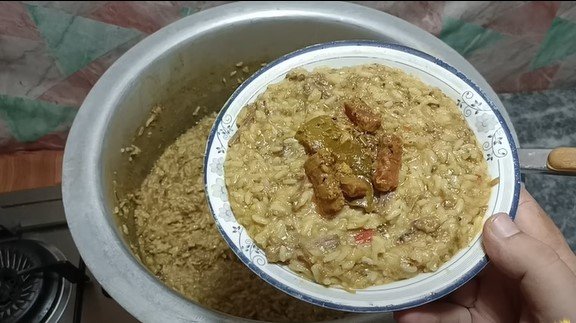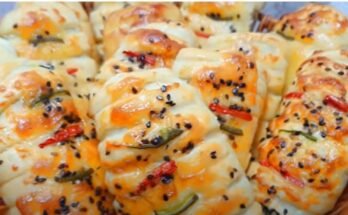As the holy month of Ramadan approaches, Muslims around the world prepare for a time of spiritual reflection, community, and of course, special meals. In Pakistan, one dish stands out as a perfect addition to the iftar table: Charsadda’s famous Mota Chawal. This rich, flavorful rice dish is not only satisfying after a long day of fasting but also embodies the spirit of sharing and togetherness that defines Ramadan.
The Significance of Mota Chawal in Ramadan
Ramadan is a time when families and communities come together to break their fast, and what better way to do so than with a hearty, comforting dish like Mota Chawal? This beloved recipe from Charsadda, a city in Khyber Pakhtunkhwa, Pakistan, has been gracing iftar tables for generations.
Why Mota Chawal is Perfect for Iftar
- Nutrient-dense: After a day of fasting, it’s crucial to replenish your body with a balanced meal. Mota Chawal, with its combination of rice, meat, and legumes, provides a good mix of carbohydrates, proteins, and fats.
- Satisfying: The short-grain rice used in Mota Chawal absorbs flavors beautifully and has a hearty texture that leaves you feeling content and energized for the night ahead.
- Easy to digest: Despite being a substantial dish, Mota Chawal is relatively easy on the stomach, making it suitable for breaking the fast.
- Shareable: In the spirit of Ramadan, Mota Chawal is typically made in large quantities, perfect for sharing with family, friends, and neighbors.
Ingredients for Ramadan Special Mota Chawal (Serves 12-14)
Before we begin our culinary journey, let’s gather the ingredients for this special Ramadan version of Mota Chawal:
- 1 kg Mota Chawal (short-grain rice)
- 1 kg beef (boneless, cut into large 6-8 inch pieces)
- 200 grams whole mung beans
- 400 grams ghee
- 1 medium onion, finely chopped (for cooking beef)
- 3 medium tomatoes
- 1 tablespoon garlic paste
- Spices:
- 4 tablespoons salt (divided)
- 2 tablespoons coriander powder
- 1.5 tablespoons red chili powder
- 1 tablespoon garam masala
- 1 tablespoon turmeric powder
- 5 liters of water (divided)
- 1/2 small onion (for garnish)
- Optional: Red chili powder for garnish
Preparing Mota Chawal: A Step-by-Step Guide
Step 1: Cooking the Beef
- In a pressure cooker, combine the beef pieces with the finely chopped medium onion, tomatoes, 1 tablespoon of salt, garlic paste, and 2 liters of water.
- Cook on medium heat for about 25-30 minutes until the beef is tender.
- Once done, separate the meat from the broth and shred it into fine pieces. Set aside both the meat and the broth.
Step 2: Preparing the Mung Beans
- In a large pot, add 3 liters of water and the washed mung beans.
- Cook for 25-30 minutes on medium heat until the beans split in half when pressed.
Step 3: Adding the Rice
- Wash the rice thoroughly. Remember, we’re not soaking the rice – this is crucial for achieving the right texture.
- Add the washed rice directly to the pot with the mung beans.
- Add the reserved beef broth to the pot. You should have about 4.75 liters of liquid in total.
Step 4: Seasoning the Dish
- Add the remaining spices to the pot: 3 tablespoons of salt, coriander powder, red chili powder, garam masala, and turmeric powder.
- Mix well and cover the pot. Let it cook on medium heat for 8-10 minutes.
Step 5: Combining Flavors
- After 10 minutes, add the shredded beef to the pot and mix gently.
- Add about one-third of the ghee (approximately 130 grams) to the pot.
- Reduce the heat to medium-low and cook for another 35-40 minutes, stirring occasionally to prevent sticking.
Step 6: The Final Touch
- In a separate pan, heat the remaining ghee for 10 minutes until very hot.
- Add half a small, finely chopped onion to the ghee and fry until golden.
- Optional: Add a sprinkle of red chili powder to the ghee for extra color and flavor.
Step 7: Finishing the Dish
- Once the rice is cooked and has absorbed all the liquid, turn off the heat.
- Pour the hot ghee mixture over the rice.
- Cover the pot and let it sit for 2-3 minutes to allow the flavors to meld.
Serving Suggestions for Iftar
As the call to Maghrib prayer signals the end of the day’s fast, serve the Mota Chawal hot. Here are some serving suggestions to enhance your iftar experience:
- Pair with Yogurt: Serve a side of cool yogurt or raita to balance the rich flavors of the Mota Chawal.
- Fresh Salad: Offer a crisp salad with cucumbers, tomatoes, and onions to add a refreshing element to the meal.
- Pickle: A tangy pickle can provide a nice contrast to the savory rice dish.
- Hydration: Don’t forget to serve plenty of water or a traditional Ramadan drink like Rooh Afza to help rehydrate after a day of fasting.
Tips for Preparing Mota Chawal During Ramadan
Plan Ahead
Ramadan can be a busy time, so consider preparing some components of the dish in advance. You can cook the beef and mung beans earlier in the day, making the final assembly quicker when it’s time to prepare iftar.
Adjust Spice Levels
While fasting, some people may find their taste buds more sensitive. Feel free to adjust the spice levels to suit your family’s preferences during Ramadan.
Make Extra
Consider making a larger batch of Mota Chawal. Leftovers can be a blessing during Ramadan, providing a quick and satisfying suhoor (pre-dawn meal) option.
Involve the Family
Preparing Mota Chawal can be a great way to involve family members in iftar preparation, fostering a sense of togetherness and teaching younger generations about traditional recipes.
The Spiritual Aspect of Cooking During Ramadan
Preparing a dish like Mota Chawal during Ramadan can be more than just cooking – it can be a form of ibadah (worship). Here’s how you can infuse spirituality into your cooking process:
- Set your intention: Before you begin cooking, make the intention that you’re preparing this meal to nourish your family and potentially share with others, as an act of worship.
- Practice mindfulness: As you cook, be present in the moment. Reflect on the blessings of having food to prepare and share.
- Recite duas: While cooking, you can recite duas or dhikr. This not only adds barakat (blessings) to your food but also helps you stay connected spiritually.
- Share the blessings: Consider making extra to share with neighbors or those in need, embodying the spirit of generosity that Ramadan encourages.
Nutritional Benefits of Mota Chawal for Fasting
While Mota Chawal is a rich dish, it also provides several nutritional benefits that are particularly valuable during Ramadan:
- Sustained Energy: The combination of complex carbohydrates from the rice and protein from the beef and mung beans provides sustained energy, crucial for the long fasting hours.
- Protein: The beef and mung beans offer a good source of protein, essential for maintaining muscle mass during fasting.
- Vitamins and Minerals: Mung beans are rich in folate, magnesium, and potassium, which help replenish nutrients lost during fasting.
- Hydration: The liquid absorbed by the rice during cooking helps contribute to your overall fluid intake.
Adapting Mota Chawal for Different Dietary Needs
Even during Ramadan, it’s important to cater to different dietary needs. Here are some variations of Mota Chawal that you can consider:
Vegetarian Version
Replace the beef with a mix of vegetables like carrots, peas, and potatoes. You can also add some fried paneer (cottage cheese) for added protein.
Chicken Mota Chawal
For those who prefer a lighter meat option, substitute the beef with chicken. This version cooks faster, which can be beneficial during the busy Ramadan period.
Healthier Adaptation
Use brown short-grain rice for added fiber and nutrients. Keep in mind that this will require adjusting the cooking time and liquid ratio.
Mota Chawal: A Tradition of Sharing
In many communities, preparing and sharing Mota Chawal during Ramadan has become a cherished tradition. Some families take turns hosting iftar gatherings, with Mota Chawal often taking center stage. This practice not only eases the burden of daily cooking during Ramadan but also strengthens community bonds.
Consider organizing a Mota Chawal potluck iftar with friends and neighbors. Each family can bring their own version of the dish, showcasing the subtle variations that make each household’s recipe unique.
Conclusion: Embracing Tradition and Spirituality Through Food
As we embrace the holy month of Ramadan, dishes like Charsadda’s Mota Chawal remind us of the power of food to bring people together, nourish our bodies, and connect us with our cultural heritage. This hearty, flavorful dish embodies the spirit of Ramadan – sharing, caring, and finding joy in the simple pleasures of life.
Whether you’re preparing Mota Chawal for your family’s iftar or sharing it with your community, remember that every grain of rice cooked with love and intention becomes a form of worship. As you break your fast with this comforting dish, take a moment to appreciate the blessings of food, family, and faith.
May this Ramadan bring you and your loved ones closer together, and may your iftar table always be blessed with dishes that nourish both body and soul. Ramadan Kareem!



